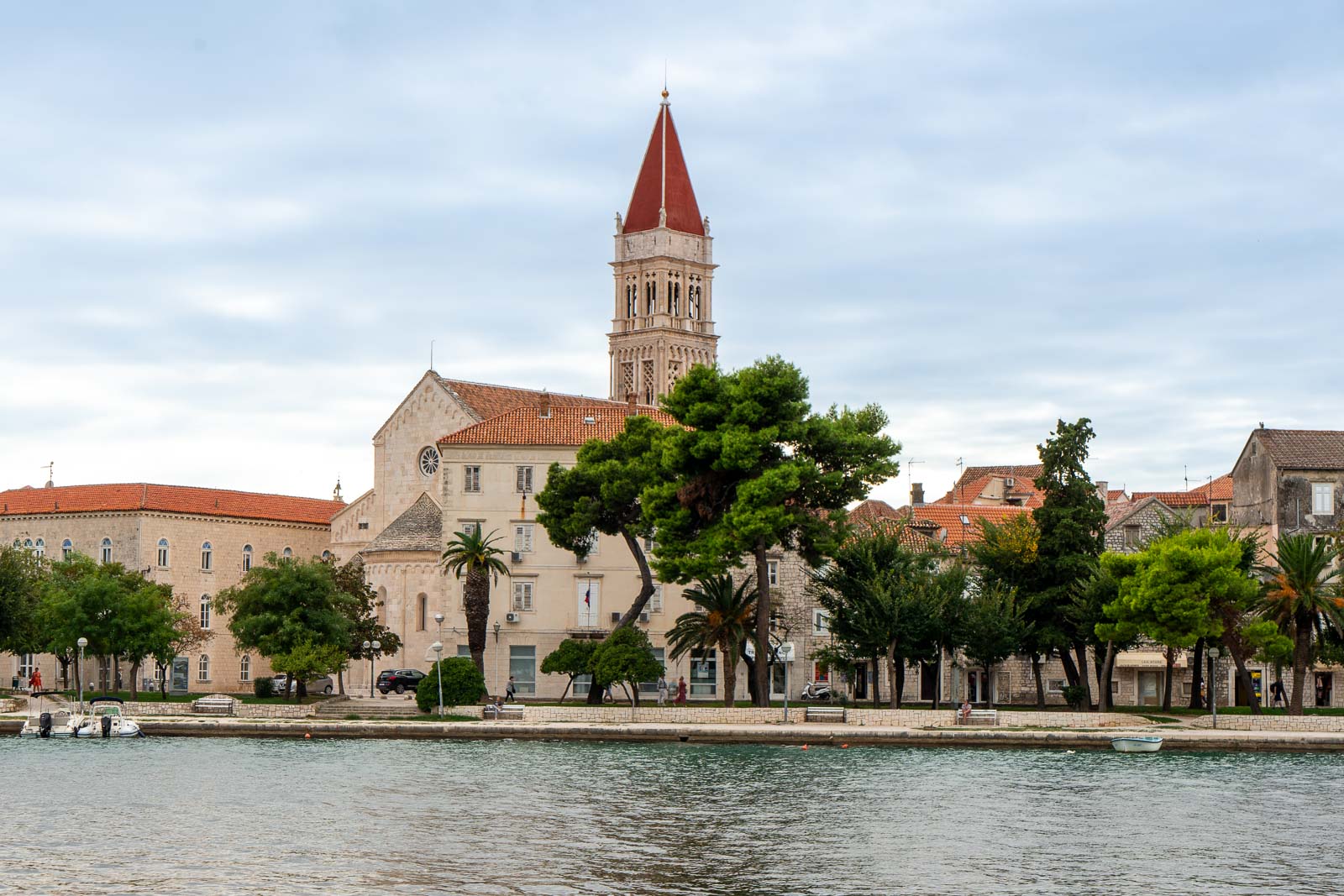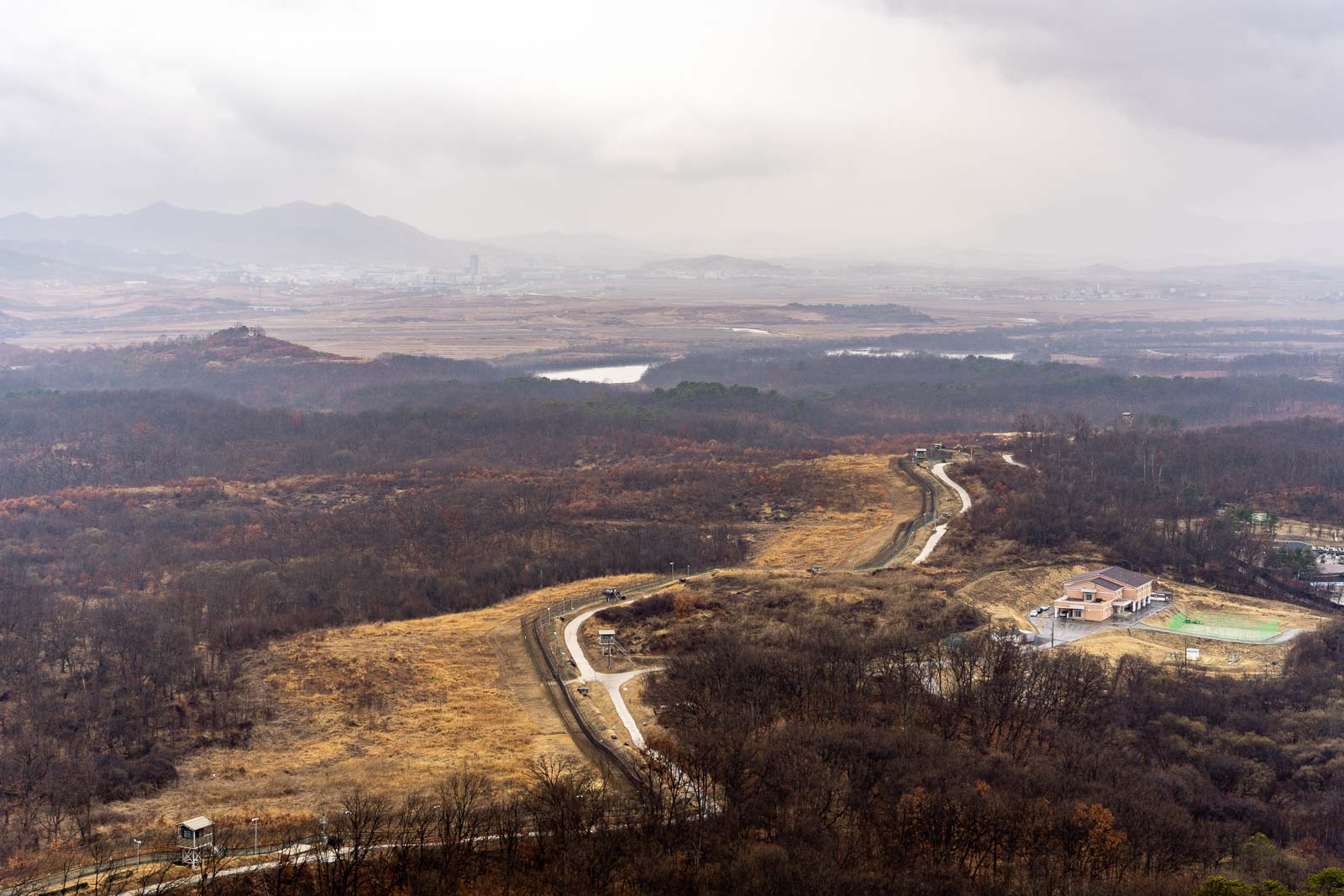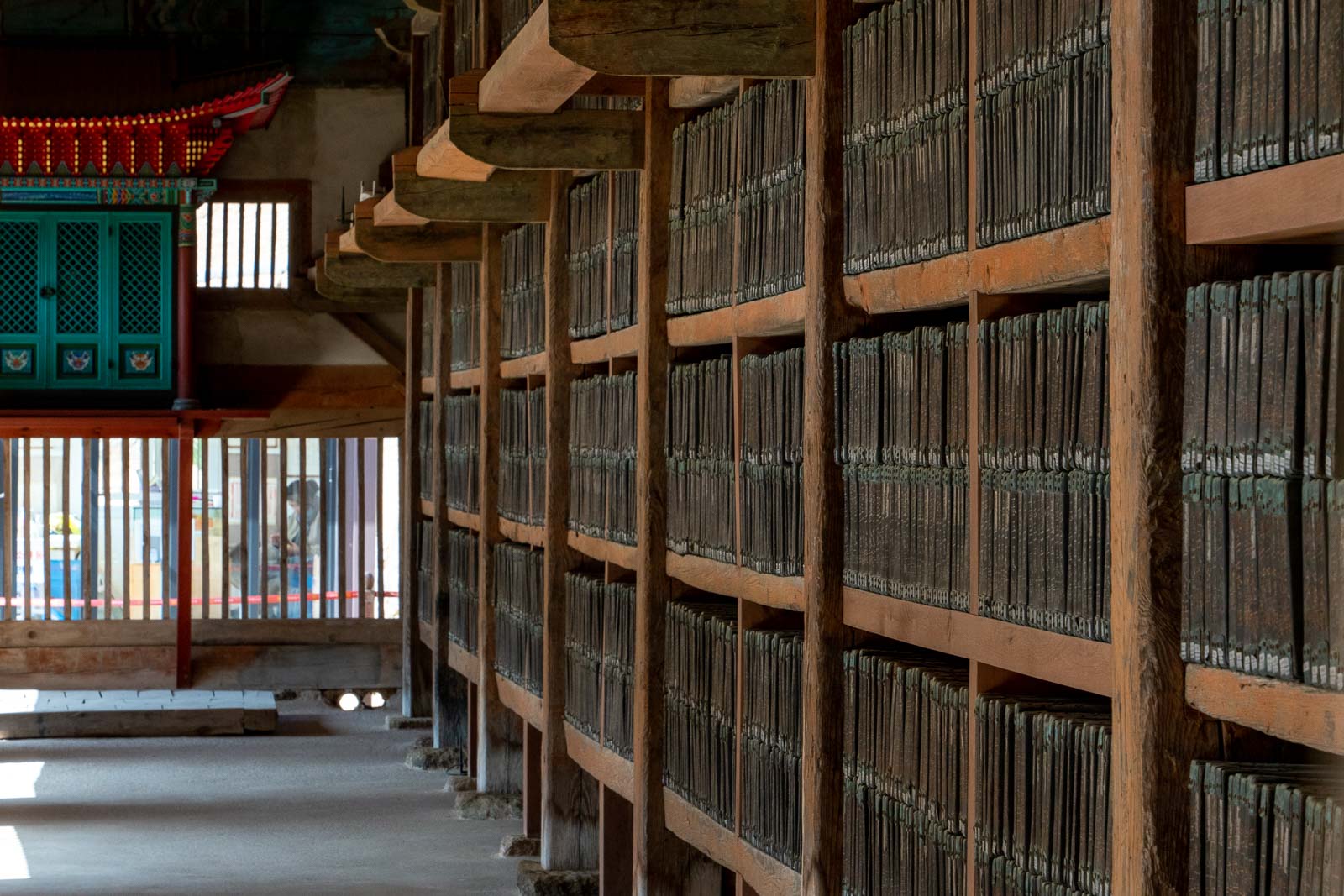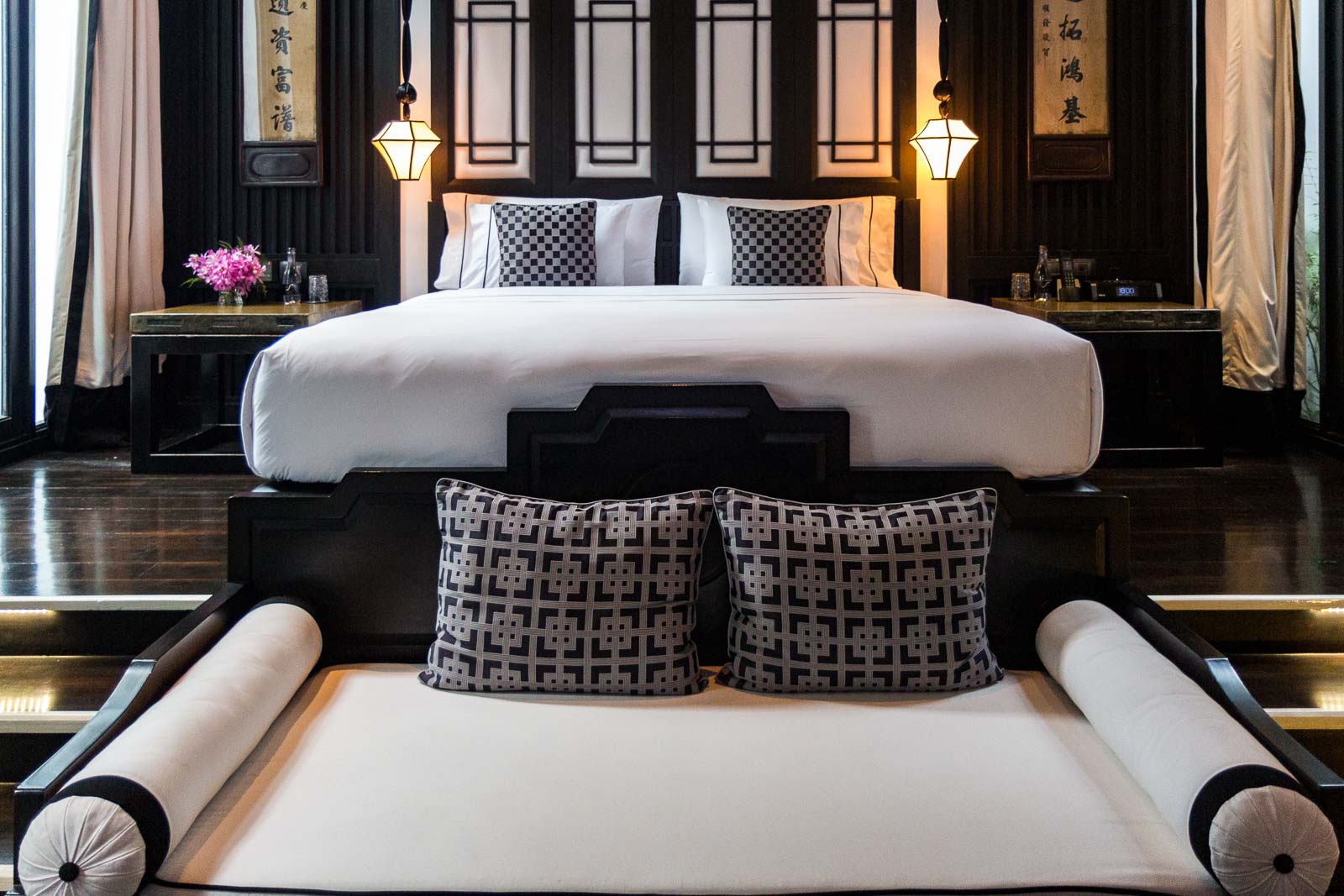Just south of Kuala Lumpur, Malayasia's second capital city is full of modern architectural marvels to explore. The post Things to do in Putrajaya appeared first on Time Travel Turtle.
Before I tell you about the things youíll see in Putrajaya, let me tell you the thing you wonít see Ė traffic!
On the wide boulevards that run through the centre of the city, down the side streets between modern buildings, along the arcing roads that connect the outer precincts, there is a smattering of cars but barely enough to make me wait for a green light when Iím crossing the road.
While the streets in the centre of Kuala Lumpur are relatively calm compared to the mayhem of Bangkok, for example, Putrajaya could almost be post-apocalyptic in its emptiness.
Is there anybody here?
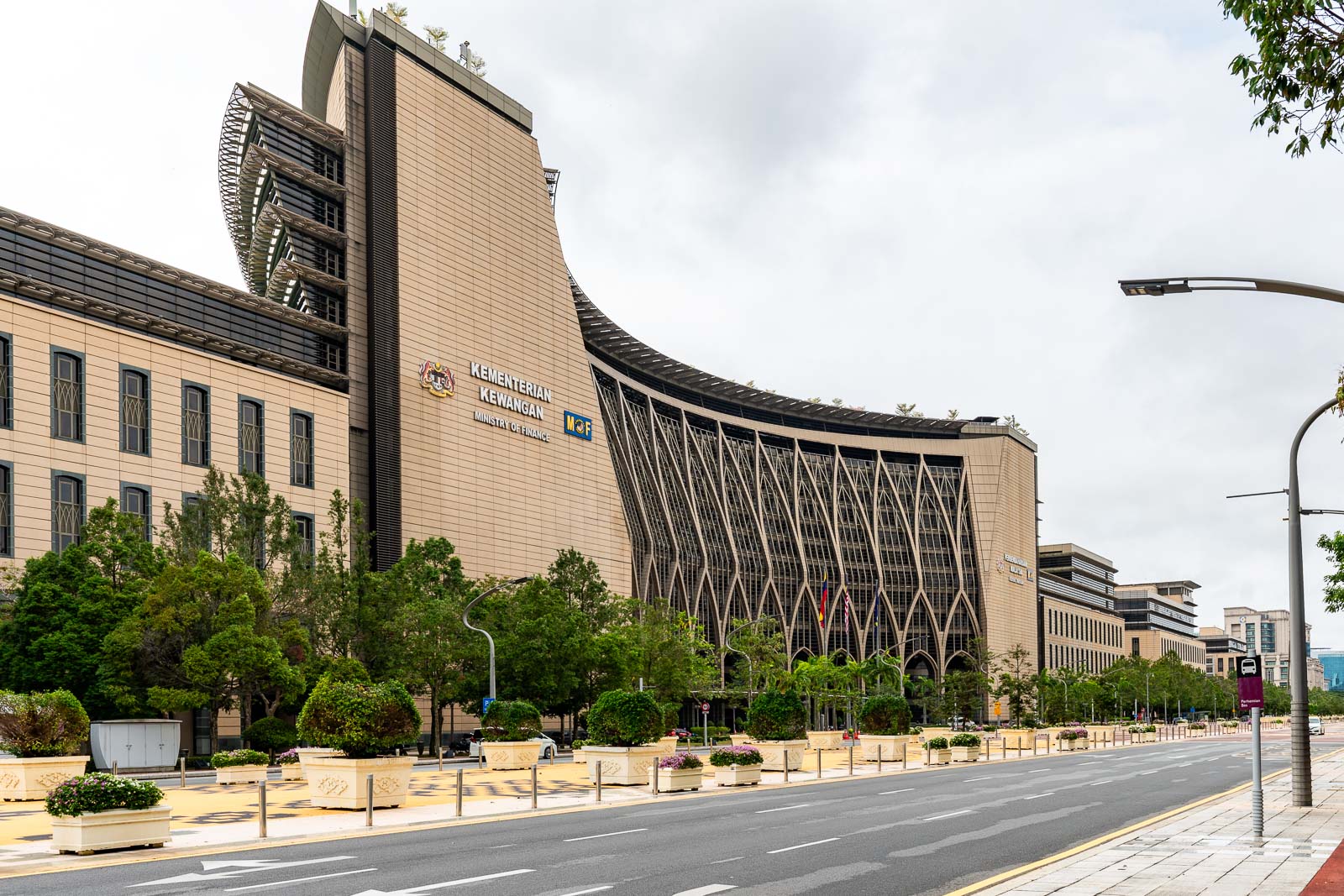
Itís a fair question to ask. The city was only created in 1995 with the vision that it would be a new capital city for Malaysia, housing the administration of the Federal Government, just 25 kilometres south of Kuala Lumpur.
The first official government workers moved to Putrajaya in 1999, the same year the Prime Minister officially took up residence here. The judiciary moved here in 2003 and gradually so did all the Malaysian government departments, with the last one relocating in 2012.
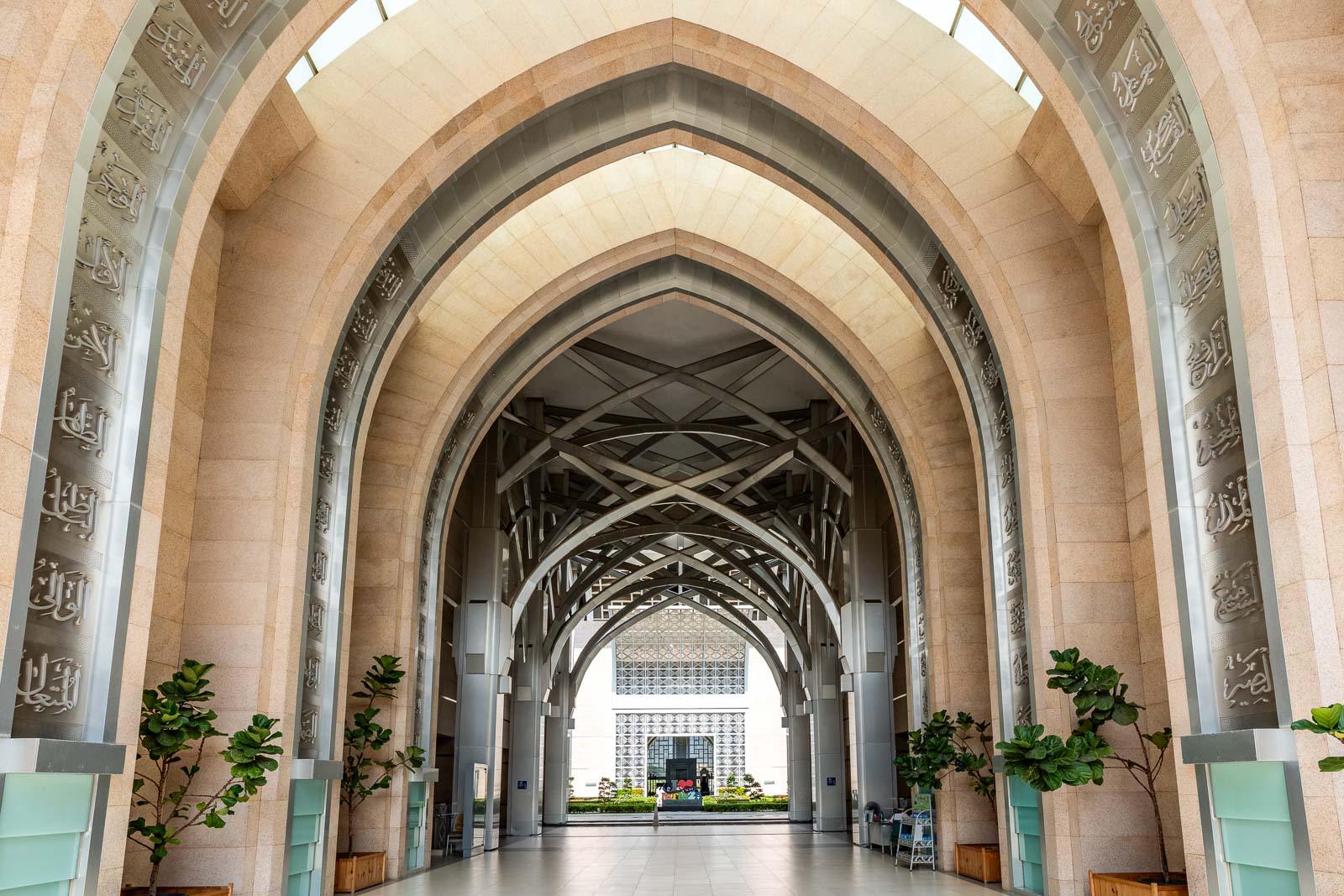
As of today, Putrajaya only has a population of about 100,000 people, compared to 8 million in KL.
(In case youíre wondering, Kuala Lumpur is still considered the official capital of Malaysia and is where the countryís head of state Ė known as the Agong Ė and the Federal Parliament is based.)
If you would like an easy way to see all the main sights of Putrajaya, I would recommend this great guided tour from Kuala Lumpur.
When you visit Putrajaya, youíll see the massive office buildings that house all the departments, often striking in their architecture.
Like the headquarters of the Malaysian Anti-Corruption Commission, which looks like something from Robocop with three towers lifted off the ground by huge pylons.
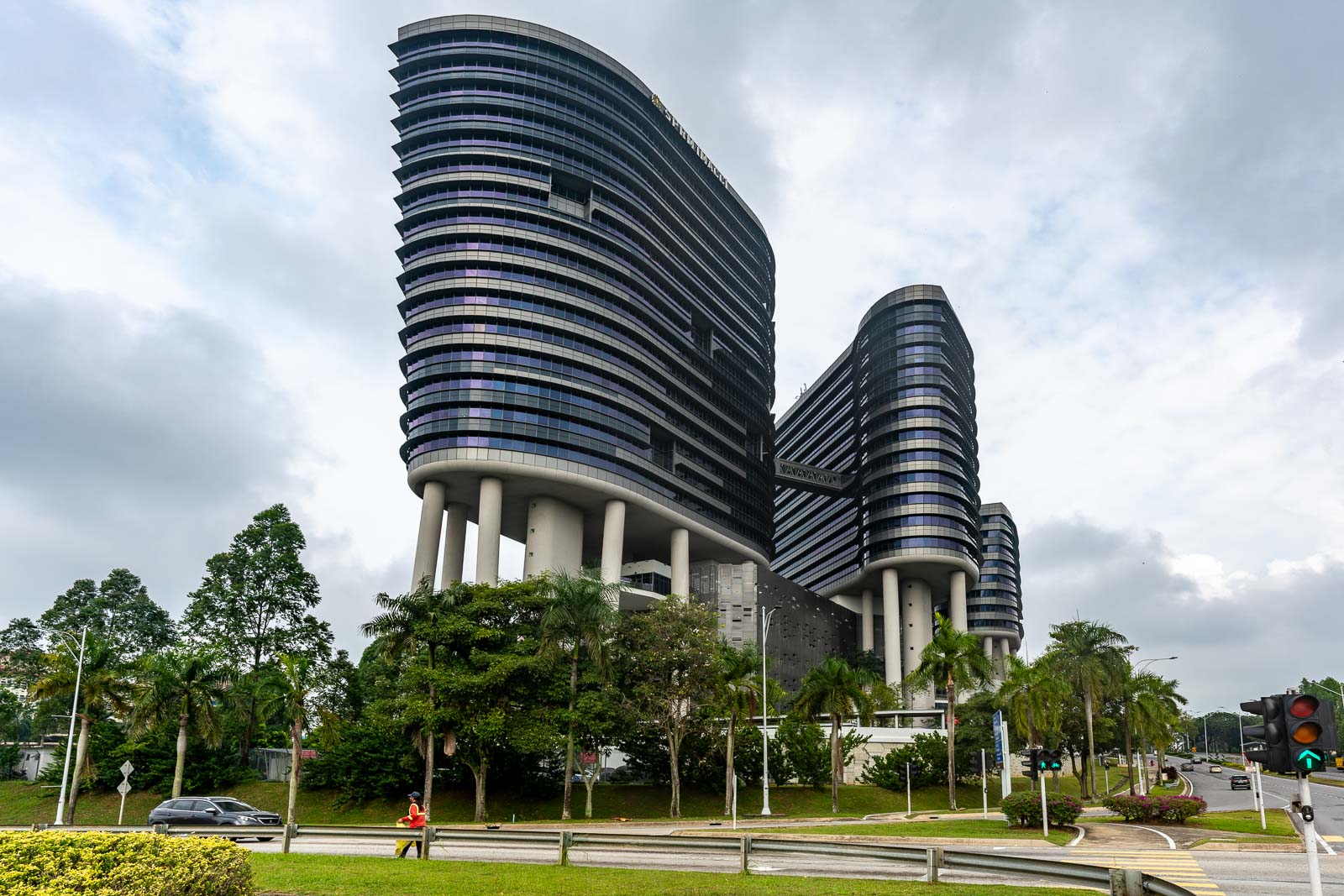
Many of my recommendations for things to do in Putrajaya involve the architecture of these government offices Ė after all, a city this modern is not full of heritage. But the advantage of planning the urban design from scratch is that you can create some impressive districts.
Itís not just any individual building in isolation that stands out (although there are certainly some highlights), itís the way that they all fit together.
How do you get to Putrajaya?
Itís easy to reach Putrajaya from Kuala Lumpur by car and it will take about 50 minutes to drive the 25 kilometres.
By public transport, the KLIA Transit is the fastest option and will take about 20 minutes from KL Sentral. The MRT is another option Ė it takes about 40 minutes but is much more regular.
How long should you spend in Putrajaya?
I think a day is long enough in Putrajaya. Youíll be able to see all the main sights in that time (even by walking). Thereís really no reason to stay overnight in Putrajaya, particularly as itís so close to Kuala Lumpur.
Is it worth visiting Putrajaya?
I think Putrajaya is definitely worth visiting. Itís a really interesting city with lots of important landmarks and some stunning modern architecture. Itís not a particularly lively place, but it offers a nice contrast to what youíll find in Kuala Lumpur.
Putrajaya was planned as a Ďgarden cityí, a concept that aimed to keep a balance between the government buildings, the residential neighbourhoods, new landscaped parklands, and the natural environment.
At its centre is a manmade lake, almost exactly the same size as Canberraís Lake Burley Griffin. Some of the main sights sit on the shore of the lake, while the water is also designed to be a natural cooling system for the city.
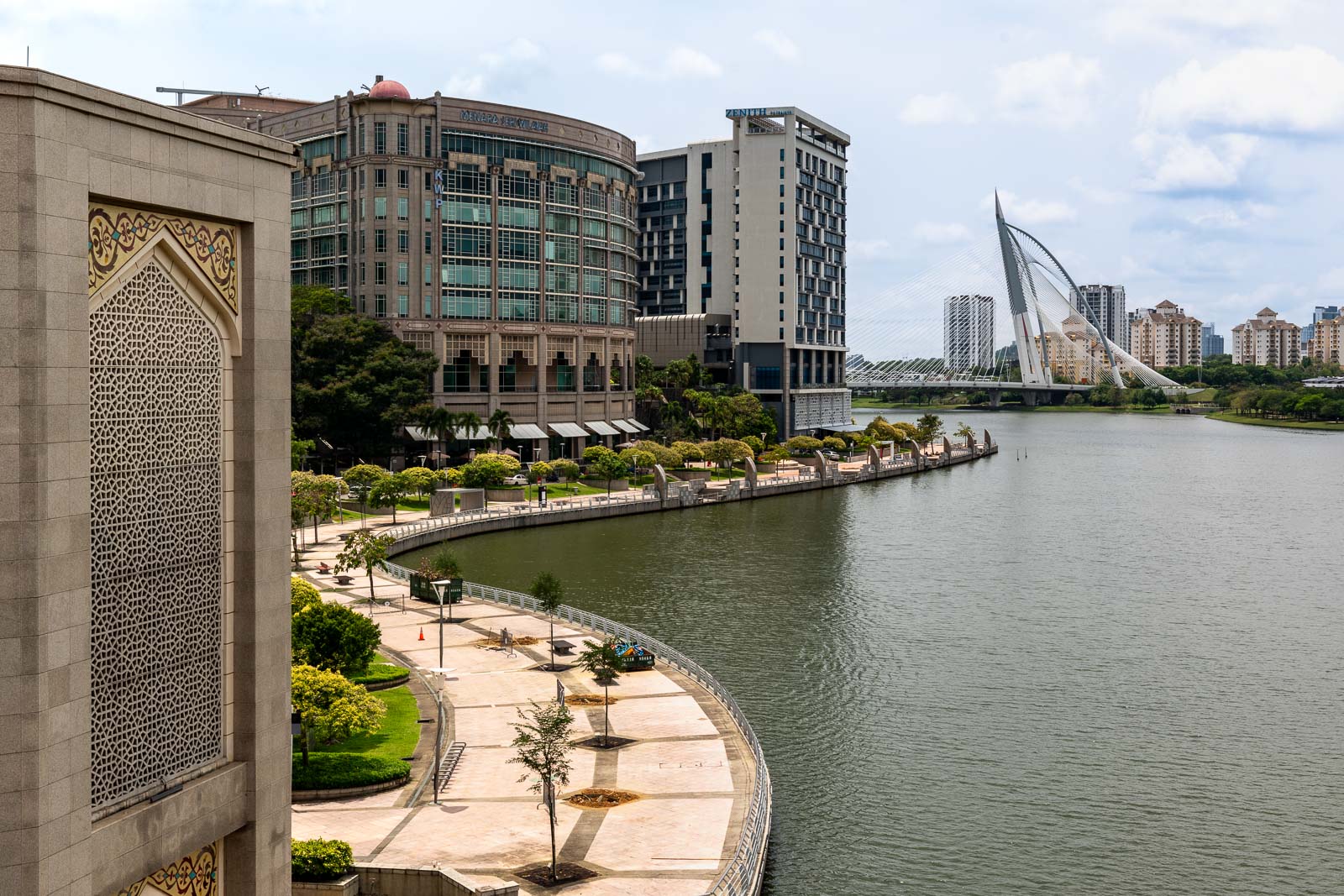
As a visitor, the lake is an attraction in itself, with gardens alongside it, boat rides on the water, and even a small beach.
So itís not just about the buildings here, there are some things to do in Putrajaya that involve the natural elements too, and finding that balance makes a trip even more enjoyable.
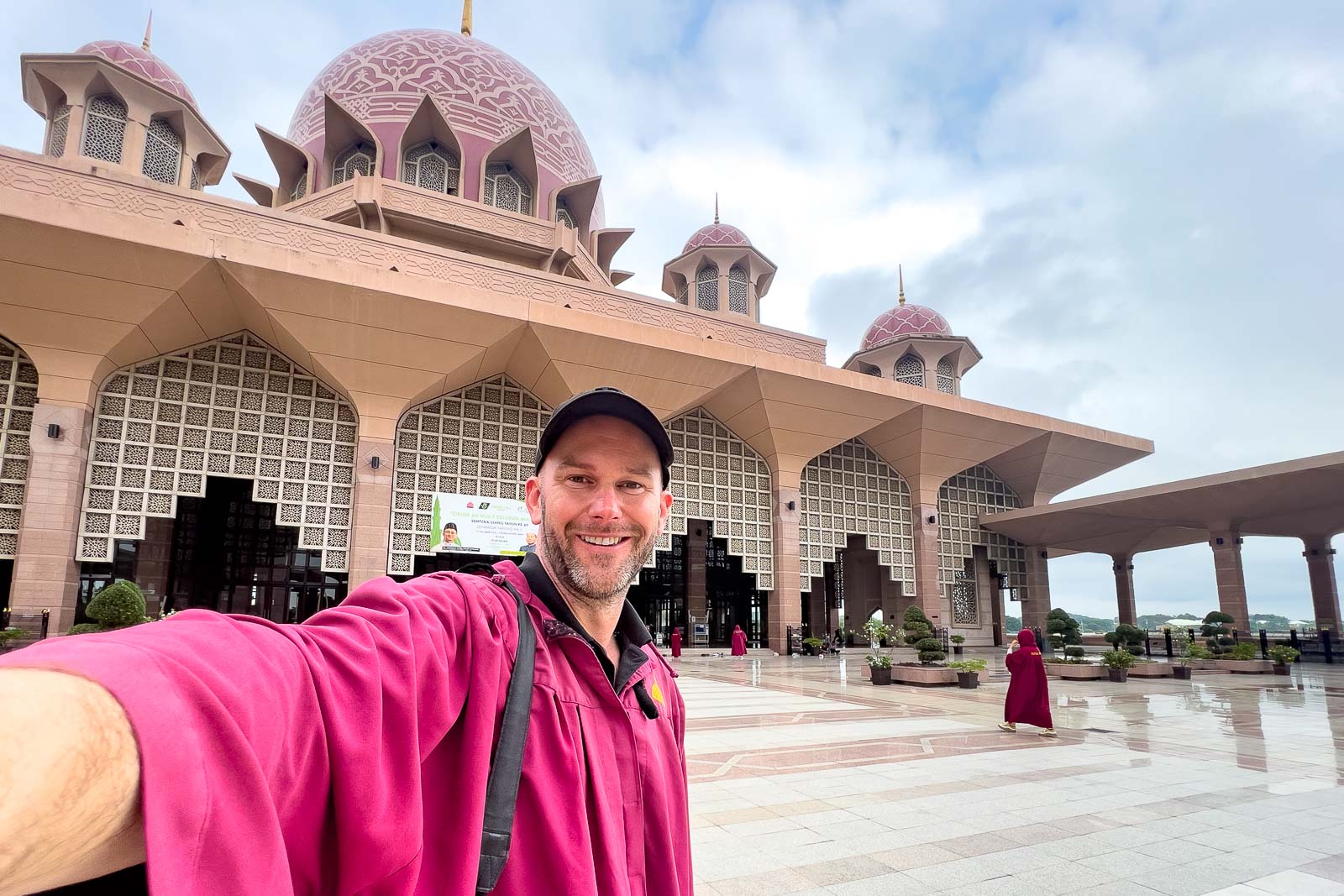
To help you with your planning, I thought I would run through my top things to see in Putrajaya, starting from the south and heading generally along the cityís main axis to the north.
That way, youíll be able to use this list in order as a guide to how to navigate your way through Putrajaya, with the start and end point about six kilometres apart.
Seri Gemilang Bridge
Even the bridges in Putrajaya are interesting, which is why I would suggest starting at Seri Gemilang Bridge, the southernmost bridge connecting the cityís central island with the other precincts.
Unlike the modern design of most of the other bridges, this one has a classical feel to it, with distinctive towers decorated by columns at each end, and lamp posts and flowerpots along its span.
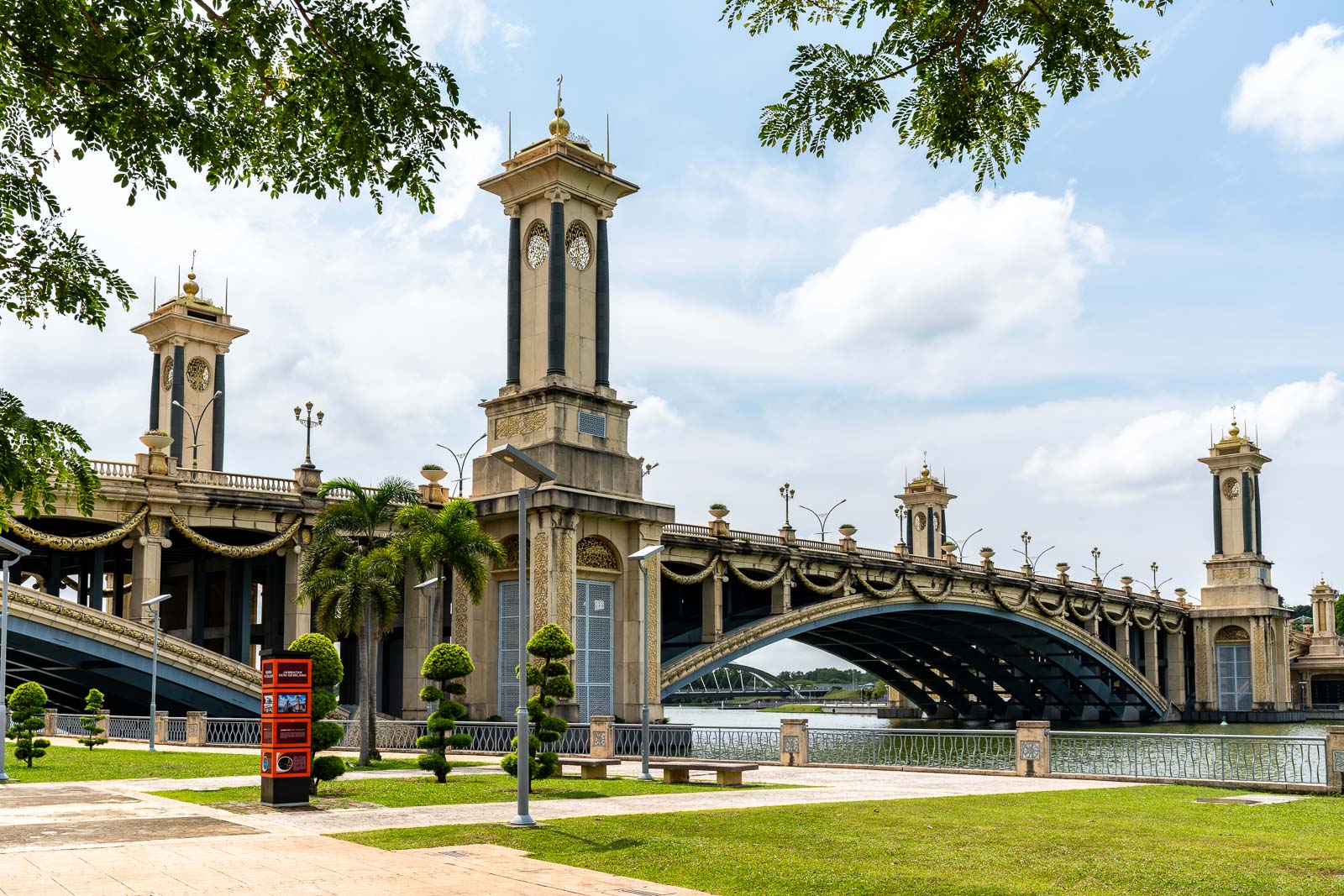
The design of the Seri Gemilang Bridge was based on the Pont Alexandre III, which crosses the Seine in Paris. Although the European style has been modified with motifs of plants from Malaysia.
At the southern end of the bridge, youíll see the Putrajaya International Convention Centre up on a hill, a large circular glass building with a sloped white roof that I think looks like a bird about to take off in flight.
Anjung Floria
From the bridge, follow the edge of the lake to reach Anjung Floria, a foreshore park that has been landscaped into different areas.
There are spots to hang out and enjoy the view, there are artworks installed throughout, and thereís even a beach called Pantai Floria where you can have a swim in the lake.
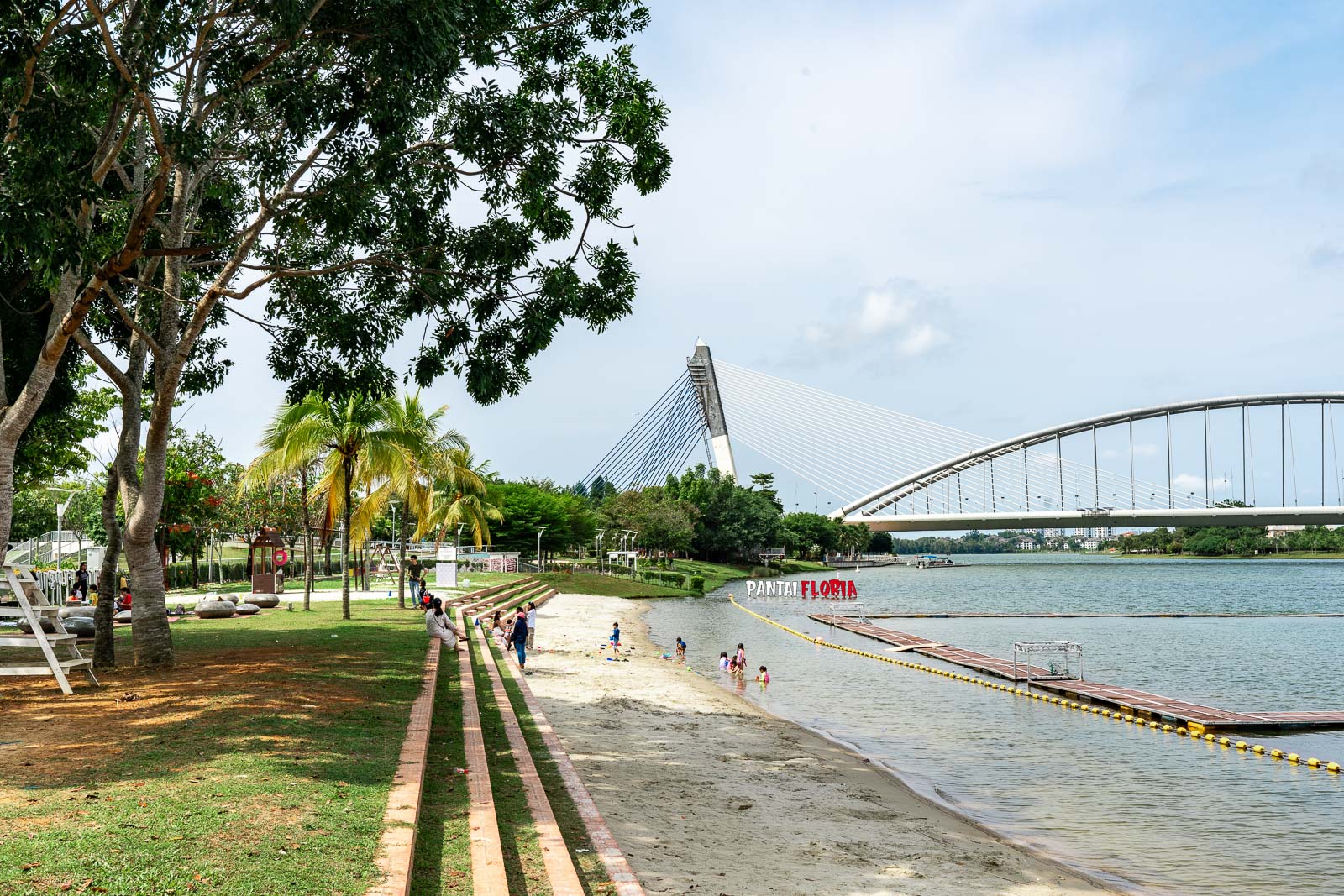
I think a highlight here is the China-Malaysia Friendship Garden, which is based on the style of a Lingnan Garden with rocks creating a sense of a mountain scene and a pavilion by a water feature.
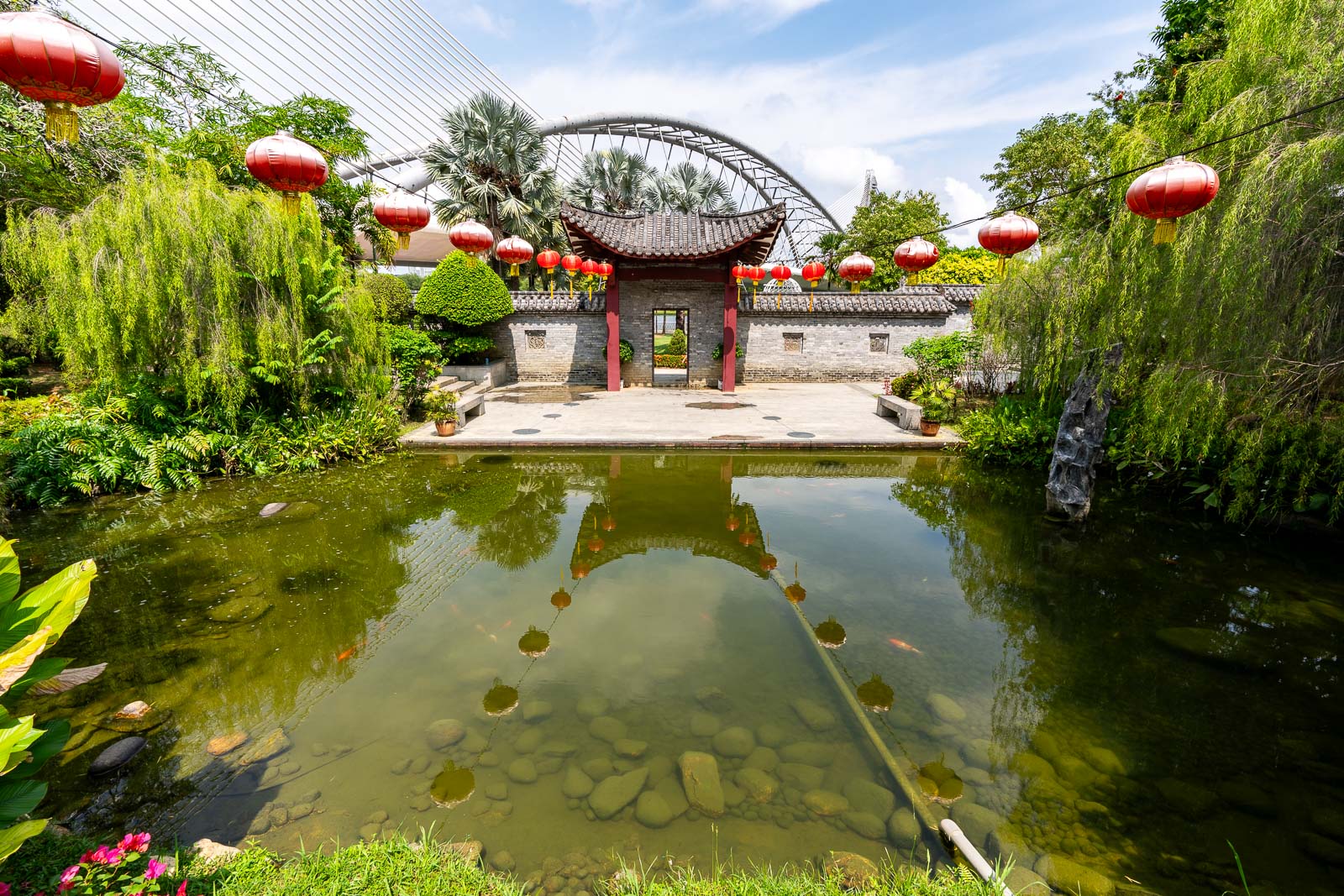
Each year, Anjung Floria also hosts a flower festival called Royal Floria Putrajaya where there are vibrant displays and lots of interesting natural artworks to discover.
The Iron Mosque
Officially known as Masjid Tuanku Mizan Zainal Abidin, most people just refer to it as the Iron Mosque Ė and you can see why! With a unique design, the mosque is constructed mainly with steel (about 70%), and the rest of the building being mostly concrete.
Architecturally, there are so many interesting things about the Iron Mosque. The walls are particularly cool (literally) because they are made from a steel mesh that lets air flow through but keeps out sun and rain.
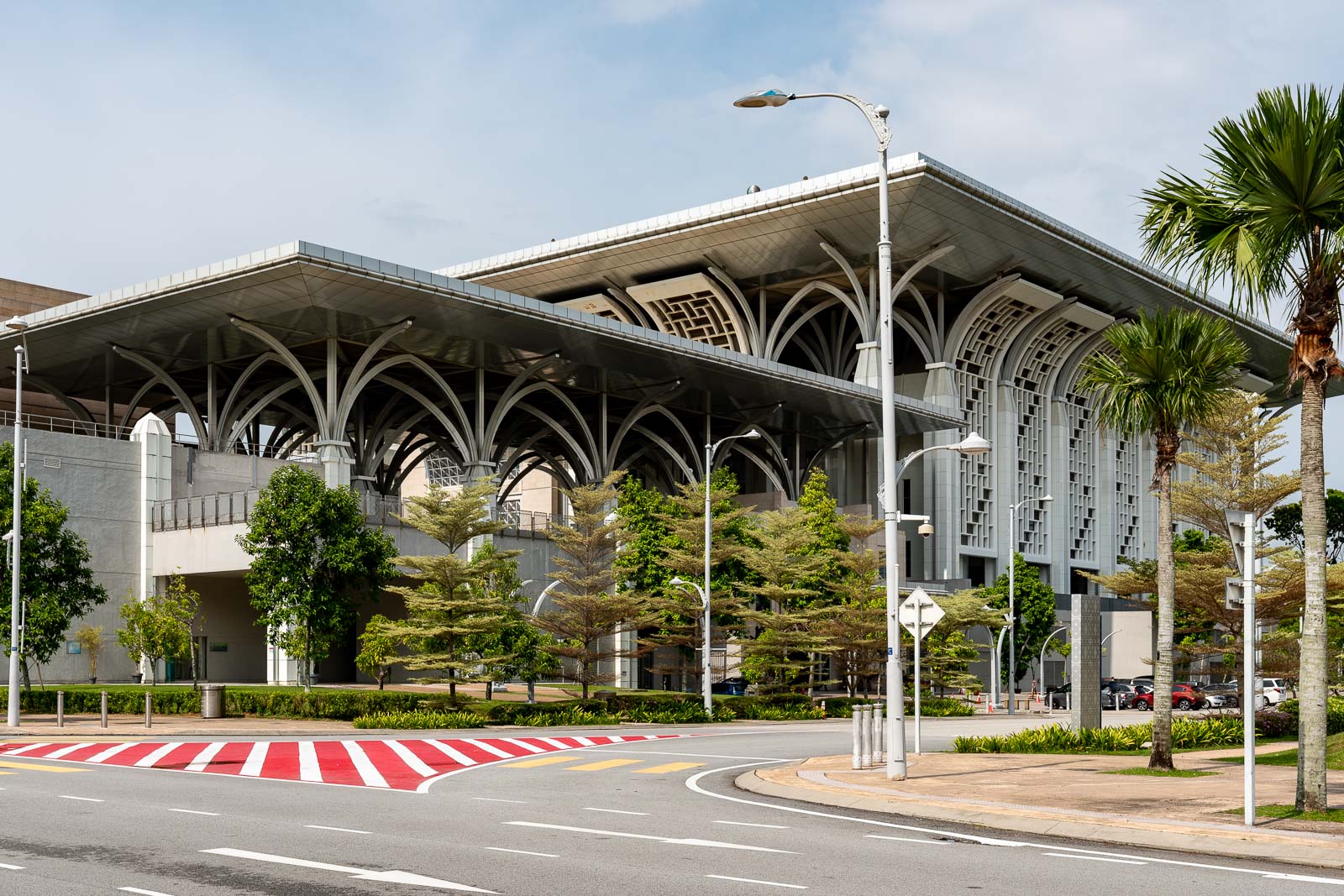
Unlike most mosques, Masjid Tuanku Mizan Zainal Abidin doesnít have a minaret, which is just another of the elements showing how this is a modern design that is supposed to stand out.
The Iron Mosque is Putrajayaís second main mosque and can hold about 25,000 people (the main one, Putra Mosque, holds about 15,000). As a tourist, you can go in and have a look, but it doesnít open to visitors until about 15:00 on Fridays.
Perbadanan Putrajaya Complex
From the entrance of the Iron Mosque, walk across the skyway ( decorated with ornately decorated panels) and youíll reach a building called the Perbadanan Putrajaya Complex.
This is the office of the local administrative body that manages the city. Separated into two wings, itís whatís in the middle that is most impressive.
A ten-storey metal arch creates a frame that puts the mosque right in the centre if looking from the main boulevard, or leads to the Palace of Justice if looking from the mosque.
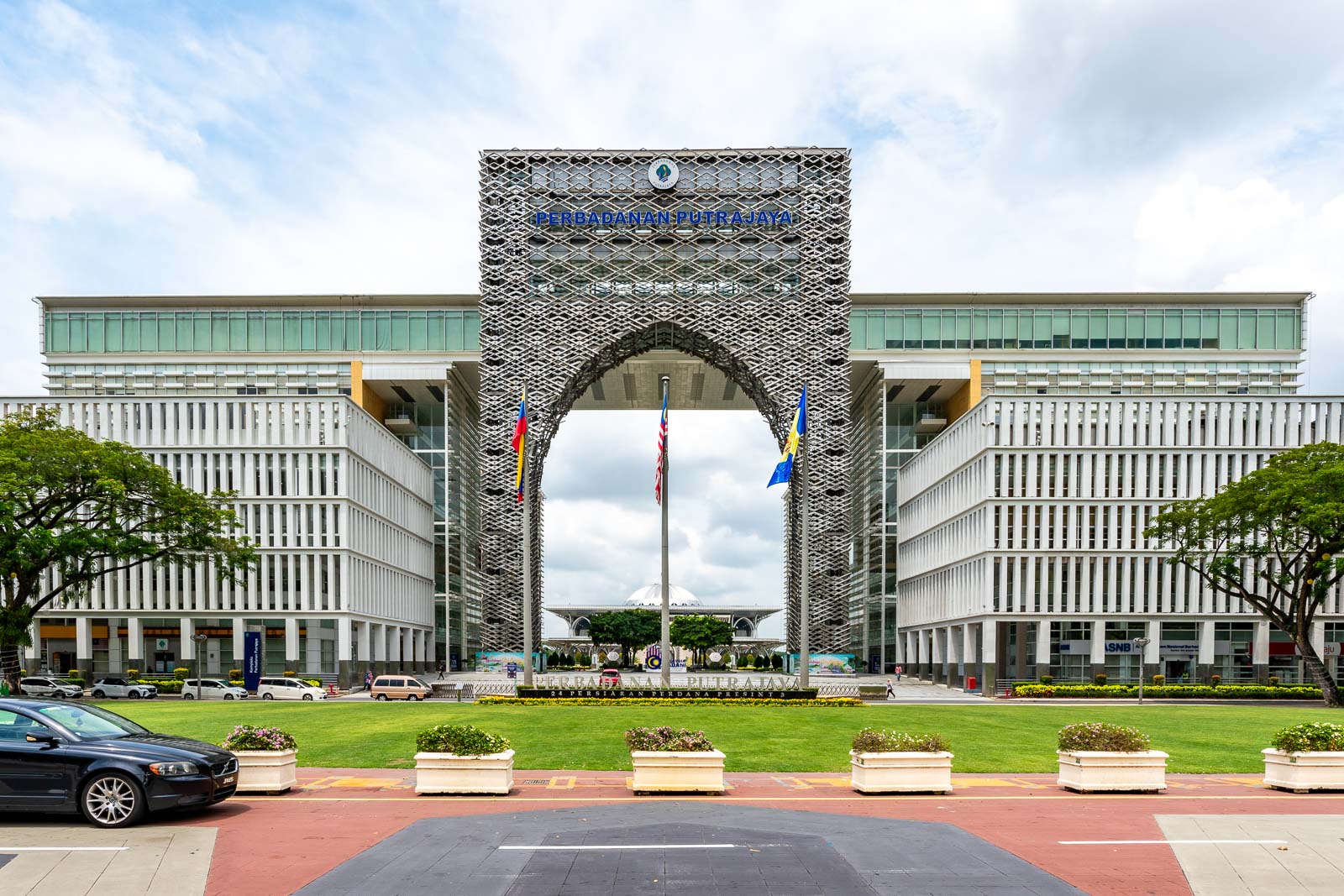
While the interiors of the Perbadanan Putrajaya Complex donít need to be explored, walking through the arch offers some great viewsÖ and leads to the next sight.
Palace Of Justice
The Palace of Justice, also known as Istana Kehakiman, is the main court complex in Putrajaya and is the equivalent of the Supreme Court or High Court that other countries have.
It has a dominant spot along the main road and is one of the most important buildings in the whole city.
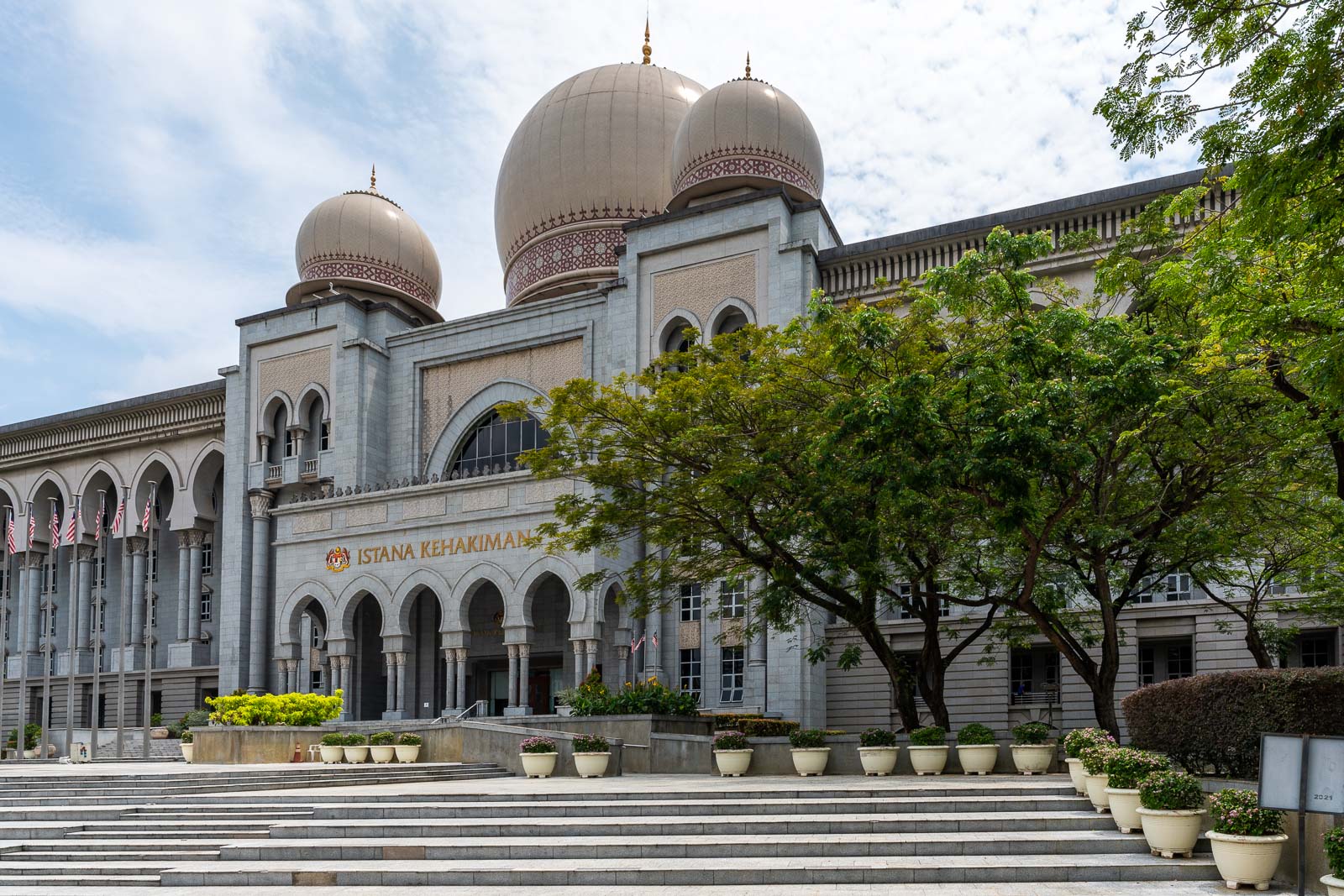
The architecture of the Palace of Justice is not as modern as some of the other buildings in the city, perhaps intentionally because of the prestigious role it plays.
The central part of the building is influenced by the Islamic architecture of the Taj Mahal, with a main dome surrounded by four others. But there are also influences from other Malaysian buildings and Western styles like Palladian.
Putrajaya Boulevard
From the Palace of Justice, walk north along the main Putrajaya Boulevard (also called Persiaran Perdana), which is four kilometres long and about 100 metres wide.
As you go along this stretch of the road, youíll pass some impressive modern buildings that give you a sense of the range of architectural styles here Ė particularly the curved Ministry of Finance.
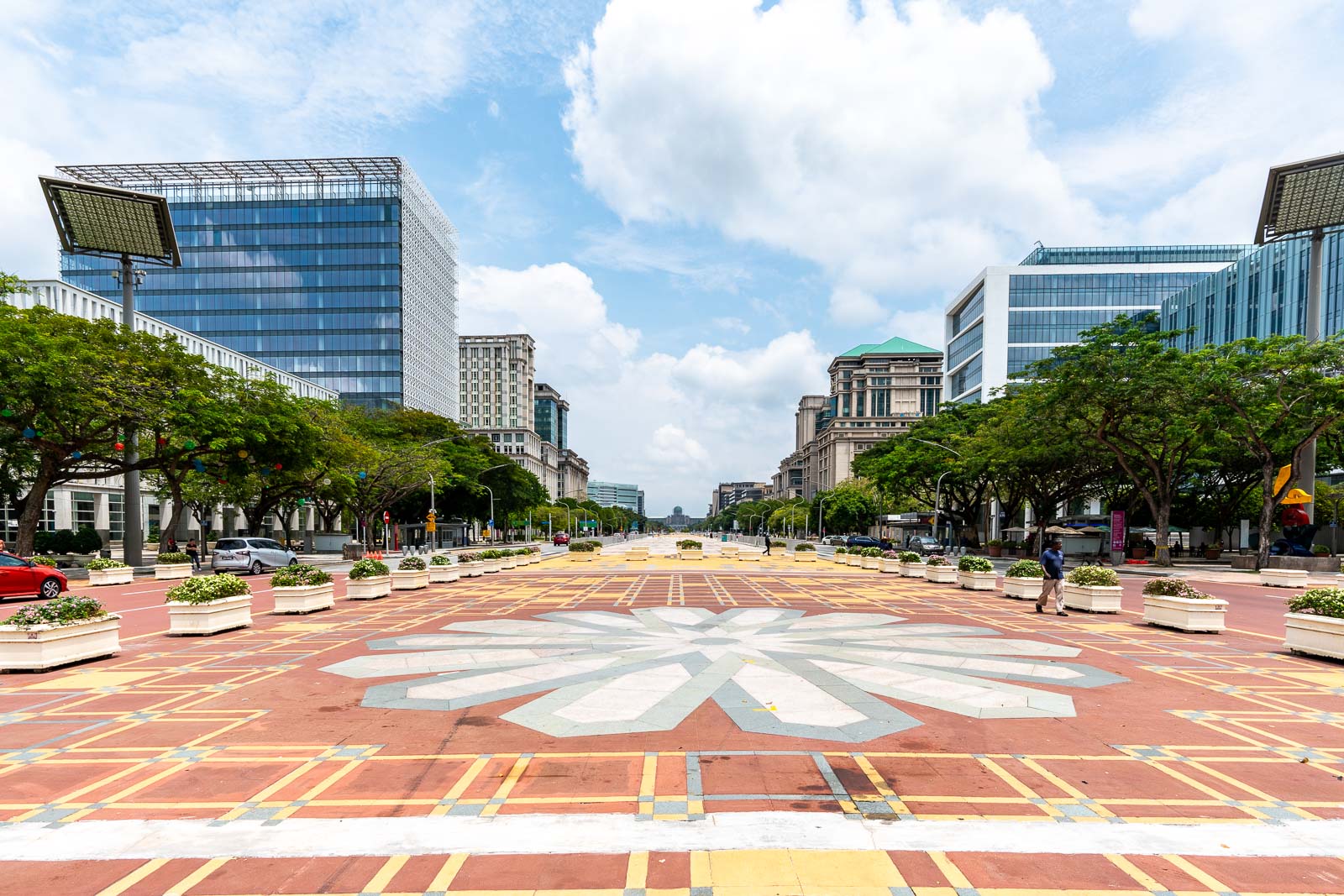
If you like, do a detour down to the foreshore of the lake to see the Millennium Monument. Made from metal, itís 68 metres tall and shaped like an obelisk, with etchings of important historical events.
You might also want to do a detour to see Seri Wawasan Bridge, which has a very different style to Seri Gemilang Bridge in the south. The futuristic structure is held up by a series of cables coming out from an inclined pylon that makes the whole thing look like a sailing ship.
Putra Square
At the end of the boulevard, across Putra Bridge, youíll reach Putra SquareÖ which is a bit of a misnomer because itís actually a circle.
While itís the buildings that come off Putra Square that are the most important things here (and Iíll talk about next), the square is worth mentioning on its own because itís a real focus for the city.
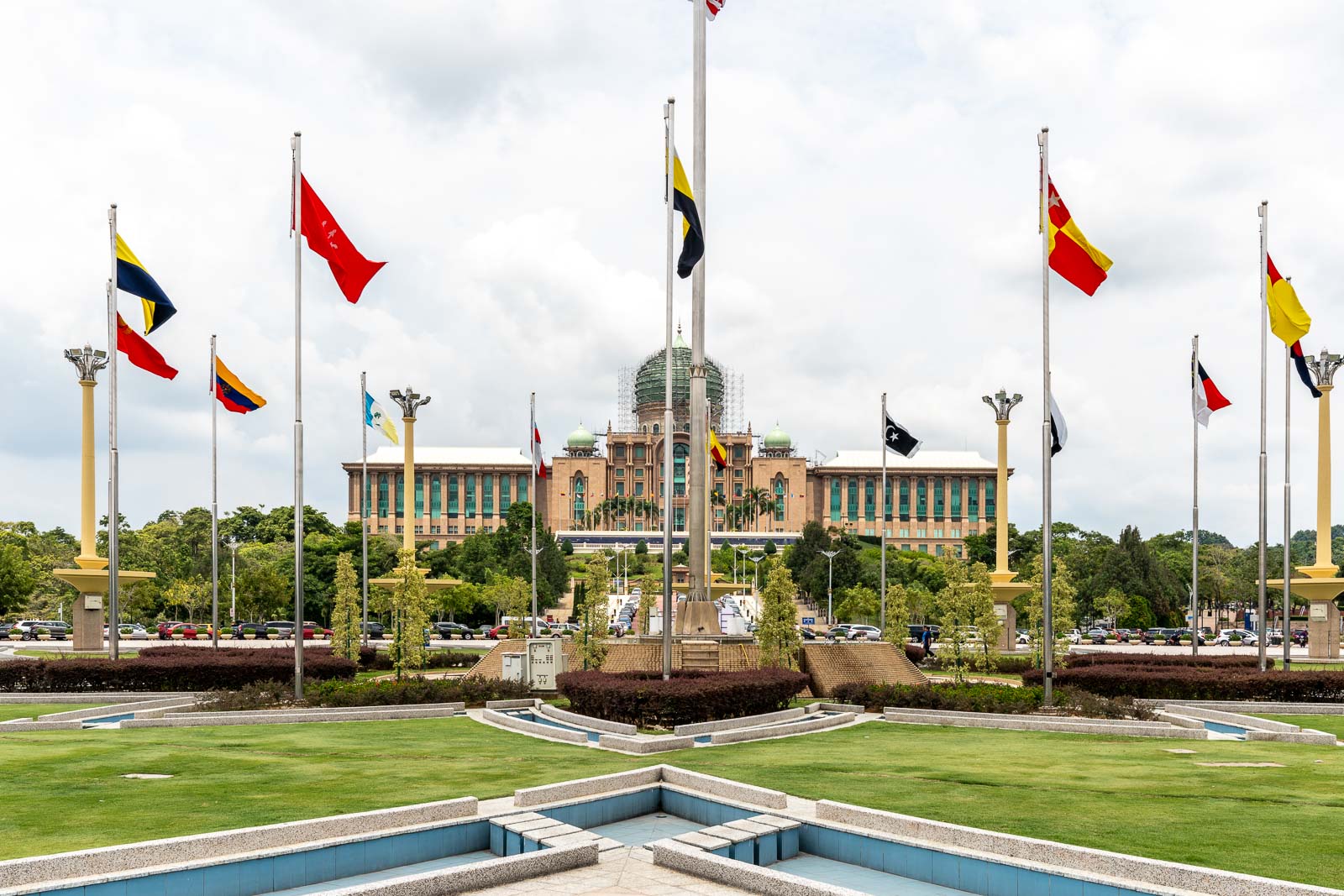
With a national flag of Malaysia lying overhead, this is where some of the cityís most iconic events take place, like the Malaysian Independence Day parade.
The design is divided into 11 segments around the outside, representing the original 11 states of Malaysia, while the inner garden bed is a star with 13 points to signify the current number of states.
Putra Mosque
Of all the things to do in Putrajaya, I think the Putra Mosque is the most significant. Not just because of its role in Malaysian culture but because the architecture is just exquisite.
The Putra Mosque is the cityís principal mosque and was one of the first landmarks to be built here. Itís constructed with rose-tinted granite that gives it the effect of an ethereal glow.
Located on the lake, youíll see its large shape from across Putrajaya but itís only when you get close youíll notice little details like the pink and white granite tiles forming a pattern on the dome.
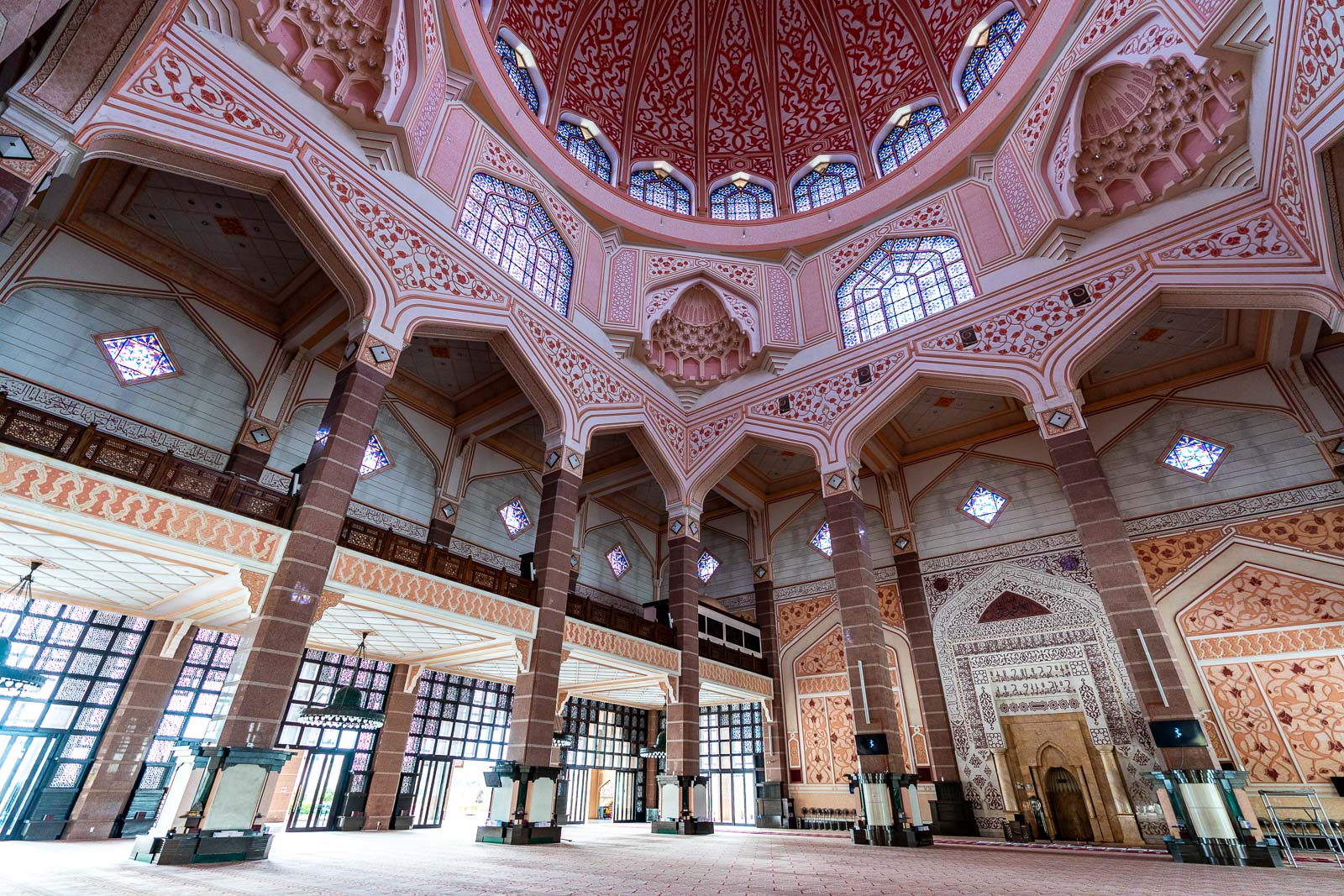
You can go inside, where the pink continues. Although the decorations on the wall are detailed, together they create a beautifully muted appearance, with a central chandelier taking much of the focus.
Although Putra Mosque is open to tourists, it is closed for prayers between 11:00 and 15:00 on Fridays.
Perdana Putra
The other prominent building on the square is the Perdana Putra, the office of Malaysiaís Prime Minister (and, considering Putrajaya was founded to be the administrative capital, arguably the cityís most important landmark).
The Perdana Putra is elevated slightly on a hill and is surrounded by its own garden. A large green onion-dome rises from the centre with an east and west wing coming off each side.
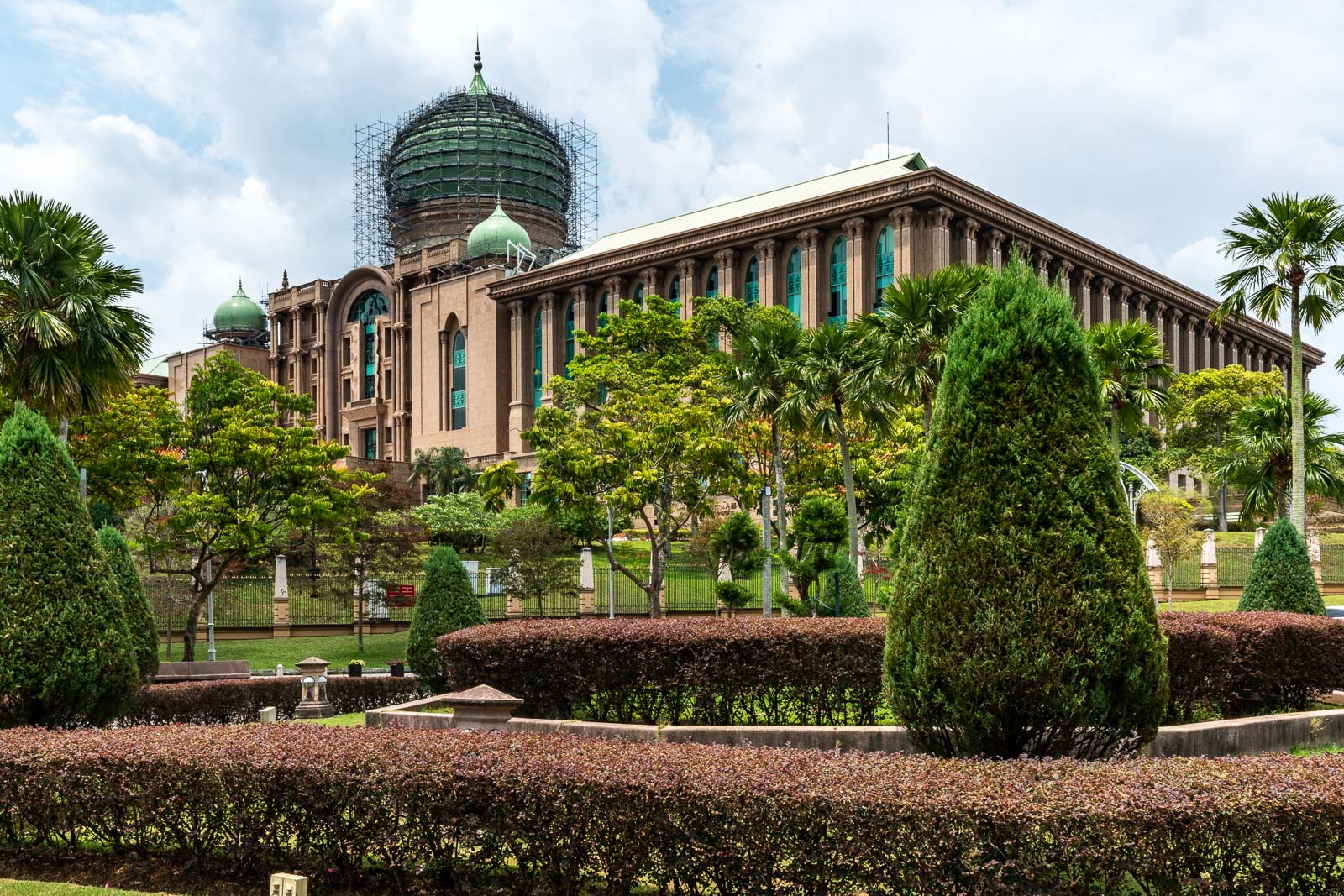
As well as the Prime Ministerís office, the building houses meeting galleries, a banquet hall, and national security centres.
The architecture is quite interesting and, whether itís intentional or not, reflects the countryís multiculturalism, with a combination of Malay, Islamic, Indian, and Western styles.
Taman Putra Perdana
From here, you can head up a series of staircases and into Taman Putra Perdana, a large park that flows across a hill. In fact, the whole park is basically the middle of an enormous roundabout (said to be the worldís largest roundabout with a circumference of 3.4 kilometres).
There are different parts of the park that you can walk through like the fragrant garden, there are gazebos for a rest, and you get some great views across the city and the lake.
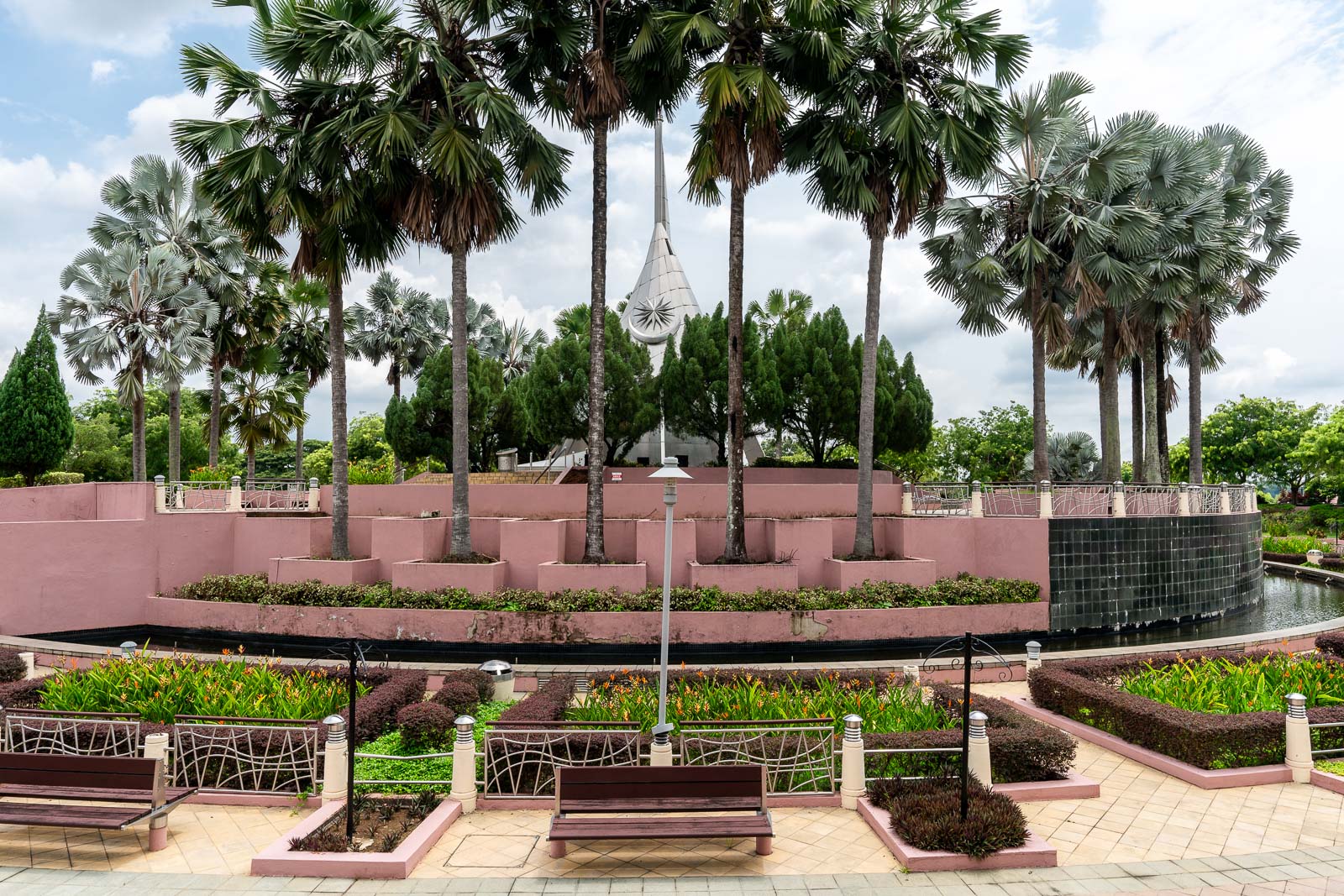
At the top, the focus is the Putrajaya Landmark (also called Mercu Tanda Putrajaya). It was the first national monument to be built in Putrajaya and is supposed to look like a time capsule to symbolise the founding of the city.
Botanical Garden
Head down the other side of the hill and cross the roundabout to reach the Putrajaya Botanical Garden (Taman Botani).
Itís quite a large site divided into different sections focusing on particular specialties, like Palm Hill, Floral Gardens, and the Lakeside.
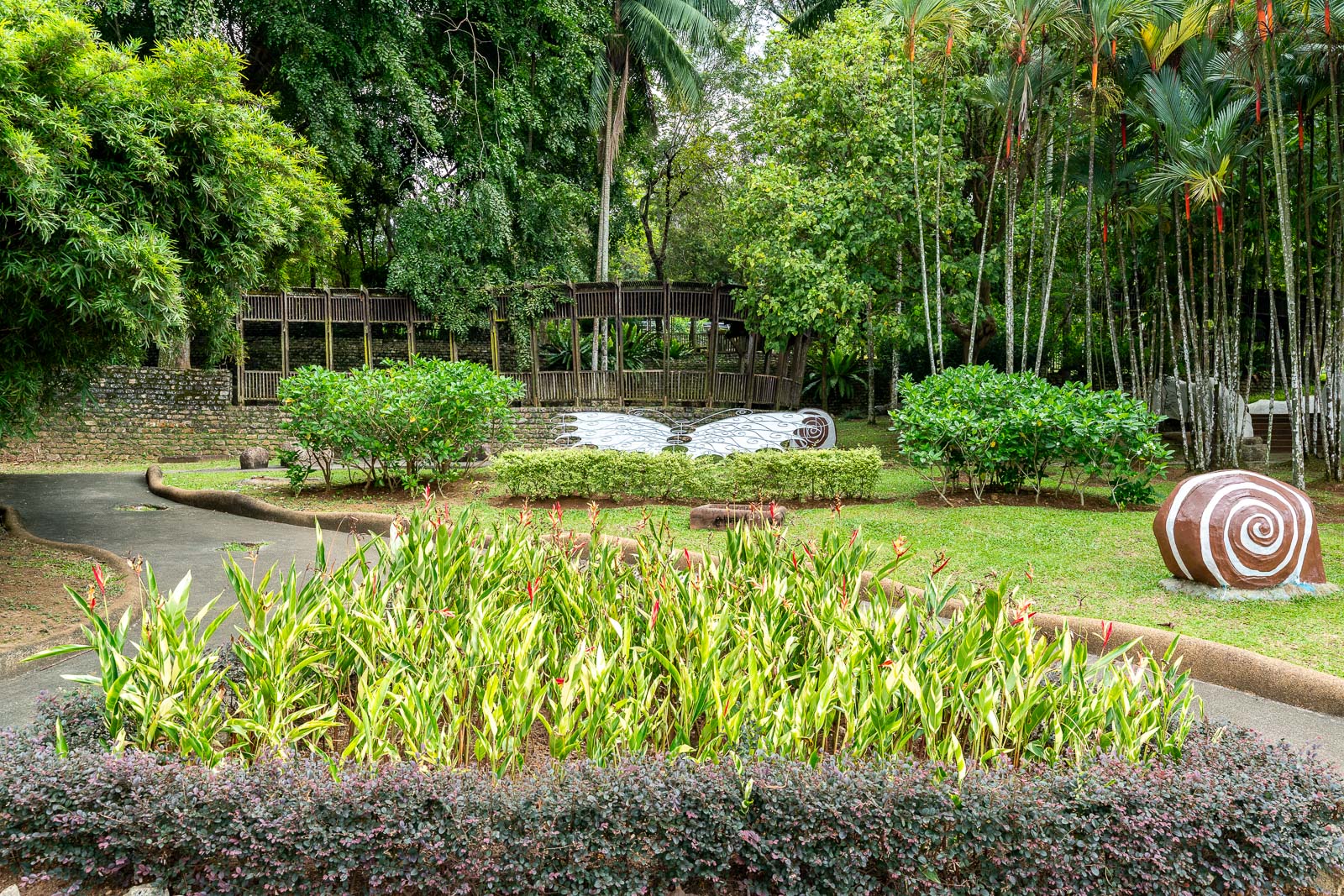
As a relatively new attraction compared to the 164-year-old Singapore Botanical Gardens for instance, there is less to see here for now because not all the plants or trees have fully grown.
But the Putrajaya Botanical Garden is a critical part of the overall masterplan to make the city a green urban centre that is carefully blended with natural elements.
Moroccan Pavilion
Although technically part of the Botanical Garden, Iím mentioning the Moroccan Pavilion (Astaka Morocco) separately because it does have its own entrance and many people will just come here to see this.
Colourful textured tiled are arranged in stunning mosaics with intricate geometric carvings across the entrance gate and main building. With a central courtyard featuring a fountain and columns, itís easy to see why this is a popular selfie spot.
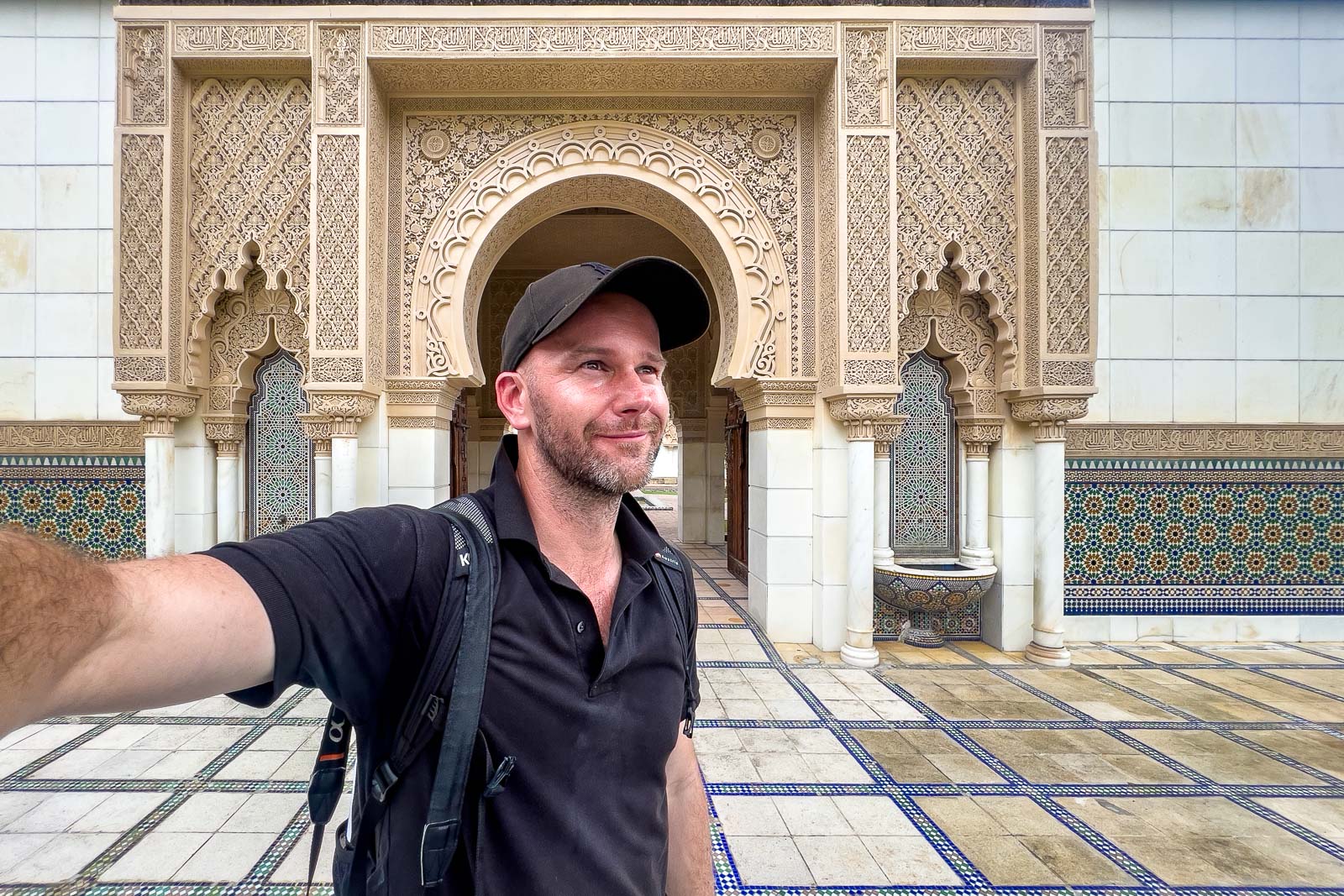
The monument was built to signify diplomatic ties between Malaysia and Morocco and features authentic Moorish architecture with materials brought from North Africa.
There is a fee to go in (just RM3, about US$0.65) while the rest of the botanical garden is free.
The post Things to do in Putrajaya appeared first on Time Travel Turtle.







